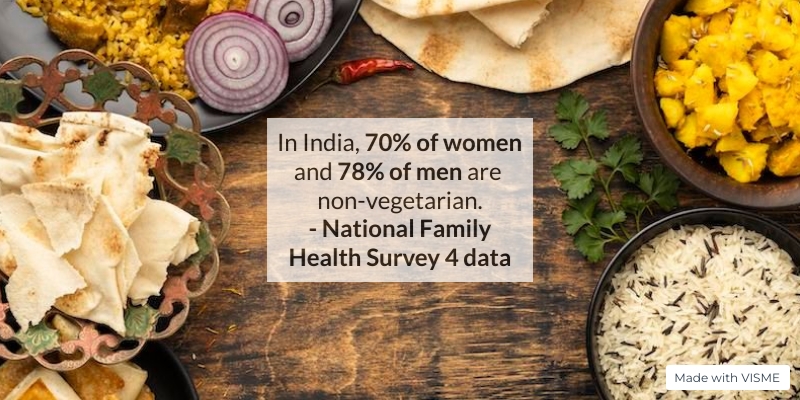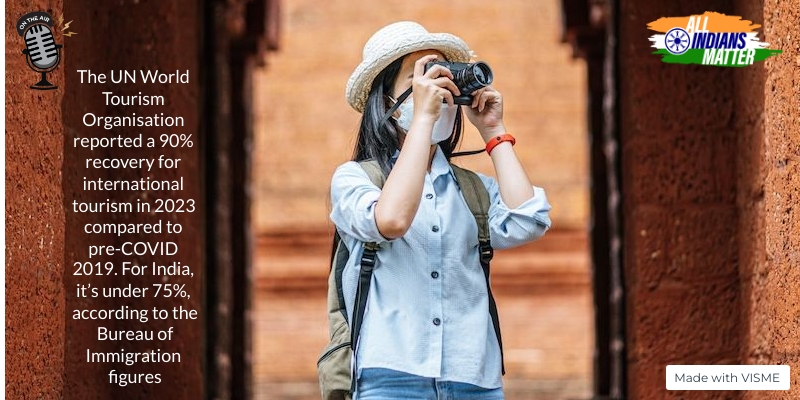Ashraf Engineer
September 30, 2023
EPISODE TRANSCRIPT
Hello and welcome to All Indians Matter. I am Ashraf Engineer.
Recently, I was on an inter-city train and the strangest thing happened. When the food service started, I asked for a non-vegetarian meal, which the staff promptly served. But two women sitting next to me, shifted to other seats. They explained to the staff that they could not sit next to someone who was eating meat or even near a meal that had it. The staff, who had obviously seen such behaviour before, gave me a knowing smile and simply went about their work while I dug in to the chicken curry. From time to time the women returned to check if I had finished, so that they could return to their seats. Eventually, I was done and they did return. The incident made me want to find out what percentage of Indians are meat eaters and whether the projection of this country as mainly vegetarian is true. I got down to it when I returned to Mumbai after a few days. As it turns out, there is government data on Indians’ daily diets. So, listen on. The findings will surprise you.
SIGNATURE TUNE
The National Family Health Survey 4 ends the debate on whether India is largely vegetarian. Its data shows that 70% of women and 78% of men consume meat. More than 400 million Indians identify as vegetarian but there have been various surveys that show the percentage of the vegetarian population is between 23% and 37%. That means 63% to 77% are non-vegetarian.
It’s a myth, a big one, that India is mainly a vegetarian country.
The National Family Health Survey data says that more than 97% of the populations of Telangana, Andhra Pradesh, West Bengal, Tamil Nadu, Odisha and Jharkhand are non-vegetarian. Punjab, Haryana, Gujarat and Rajasthan have the least non-vegetarian populations – below 40%.
There is a direct correlation between income and meat consumption. Both have risen simultaneously. According to the Organisation for Economic Co-operation and Development, in 2020, India consumed six million tonnes of meat with nearly half the population consuming non-vegetarian meals at least once a week.
Actually, this has been evident historically. India has since ancient times had widespread forests, animals, fish and birds. This ensured meat-eating was widespread. In fact, there is archaeological evidence from the Harappan civilisation that shows meat consumption.
Later, as Jainism and Buddhism spread, vegetarianism became more common and some Hindu communities turned vegetarian too. However, this was mainly an upper-caste trend. As the data proves, India remained largely non-vegetarian.
The stereotype of a vegetarian country got entrenched probably because government data shows that vegetarian households are more affluent. Since they are socially more powerful, there is what is known as a ‘food hierarchy’ in which vegetarian food occupies a higher status than meat.
Incidentally, some research claims that even the National Family Health Survey overestimates the number of vegetarians in India. A study by US-based anthropologist Balmurli Natrajan and India-based economist Suraj Jacob blames the inflated estimations on cultural and political pressures, which means that people under-report eating meat and over-report eating vegetarian food. According to them, only about 20% of Indians are vegetarian.
Hindus, who comprise 80% of the population, are major meat-eaters. Dalits and tribals are mainly meat eaters.
The debate over vegetarianism is rooted in politics. The ruling Hindu nationalist Bharatiya Janata Party promotes vegetarianism and believes the cow is holy and so it should be protected. Accordingly, several states have banned cattle slaughter and vigilante groups have murdered people transporting cattle or on suspicion of eating beef. Some of them have even been felicitated by Union ministers.
The fact, however, is that millions, including Dalits, Muslims and Christians, eat beef. About 70 communities in Kerala prefer beef because goat meat is costlier.
Natrajan and Jacob say close to 15% of Indians, or 180 million people, eat beef. That’s 96% more than official estimates.
Here’s something else to think about. India accounts for 2.18% of global meat production and ranks sixth after China, the US, Brazil, Russia and Germany, according to the Ministry of Food Processing Industries.
Meat production in India grew at 5.15% from 2014-15 to 2019-20, according to the Ministry of Fisheries, Animal Husbandry and Dairying.
Buffaloes account for 30% of India’s meat production with Uttar Pradesh at 15%, Maharashtra at 13% and West Bengal at 10% contributing the most to meat production, according to the Reserve Bank of India.
So strong is the meat industry that it was among the handful that was not affected by the COVID-19 pandemic. The Ministry of Commerce and Industry has said in the past that export of buffalo meat from India was unaffected. India clocked buffalo meat exports of $3.17 billion between April 2020 and March 2021, which was stable compared to the previous year’s exports. This makes India one of the largest exporters of buffalo meat in the world, supplying it to more than 70 countries. Of the top 10 buffalo meat exporters from India in 2018-19, seven were from Uttar Pradesh, two from Maharashtra and one from Delhi, Commerce and Industry Minister Piyush Goyal told Parliament in December 2019.
Food apartheid, however, continues. In the past, roadside stalls in Ahmedabad were banned from selling non-vegetarian food. Vadodara and Rajkot instructed vendors to keep non-vegetarian food covered so it could not be seen by passersby. Meat shops in Gurugram were ordered shut on some days. These are just a handful of attempts to enforce food choices on Indians. Another example is several states forbidding eggs in mid-day meals in schools.
The data clearly shows that a majority of Indians consume some meat – chicken, mutton, fish, eggs – regularly and vegetarianism is practised by a minority of the population.
Let’s accept that India is a complex and multi-cultural society. The attempt to police food habits is an assault on culture and on the freedom of choice. It’s part of the larger project to homogenise the population, which includes the imposition of Hindi on speakers of other languages.
Let’s not fall for a false narrative.
Thank you all for listening. Please visit allindiansmatter.in for more columns and audio podcasts. You can follow me on Twitter at @AshrafEngineer and @AllIndiansCount. Search for the All Indians Matter page on Facebook. On Instagram, the handle is @AllIndiansMatter. Email me at editor@allindiansmatter.in. Catch you again soon.






